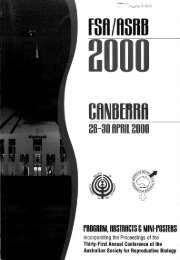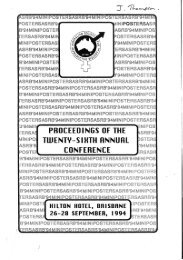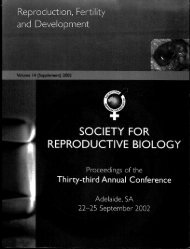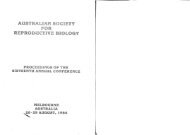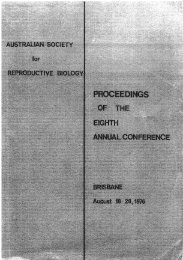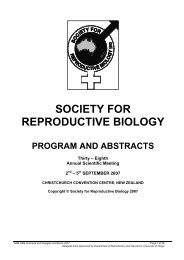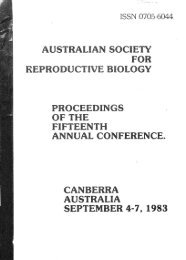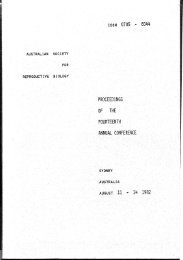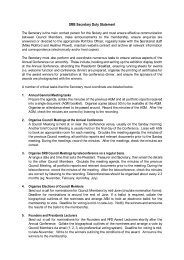N OCIETY' - the Society for Reproductive Biology
N OCIETY' - the Society for Reproductive Biology
N OCIETY' - the Society for Reproductive Biology
Create successful ePaper yourself
Turn your PDF publications into a flip-book with our unique Google optimized e-Paper software.
The effect of seminal plasma on <strong>the</strong> capacitation status offresh and frozen-thawed ramspermatozoa.C.A. McPhie, G. Evans and W.M.C. MaxwellDepartment ofAnimal Science, University of Sydney, NSW 2006 AustraliaSecretory proteins from <strong>the</strong> female reproductive tract of <strong>the</strong> brushtail possum (Trichosurus vulpecula):Binding to sperm and effects on <strong>the</strong>ir survival in vitroSidhu, K.S., Mate, K.E., Molinia*, F.e., Glazier*, A.M. and Rodger, J.e.Co-operative Research Centre <strong>for</strong> Conservation and Management of Marsupials, Macquarie University, NSW2109 Australia *Landcare Research, PO Box 69, Lincoln 8152 New ZealandIntroductionCryopreservation causes capacitation-like changes in ram spermatozoa (1) perhaps because seminalplasma, which is believed to contain decapacitation factors, is removed during preparation ofspermatozoa <strong>for</strong> freezing. In this experiment, fresh and frozen-thawed ram spermatozoa weresupplemented with seminal plasma in an attempt to limit capacitation-like membrane changes.Materials and MethodsSeminal plasma was prepared from semen collected from three mature rams (A, B and C) bycentrifugation (12000g, 15 minutes) followed by filtration (0.2).!; Milex). Pooled semen from <strong>the</strong>same three rams, fresh or frozen-thawed (as described by Evans and Maxwell; 2), was centrifuged '(600g, 15 min) through a Percoll gradient (90:45%, v/v) and <strong>the</strong>n washed (600g, 6 min) in HSOF.The washed spermatozoa were resuspended in Dulbecco's phosphate-buffered saline (DPBS). TheDPBS contained ei<strong>the</strong>r no seminal plasma (control; Con), 20% seminal plasma from rams A, B, orC orpooled from all three rams (P). Spermatozoa were assessed immediately and after 6 hrincubation (37 0 C) <strong>for</strong> motility (light microscopy) and capacitation status (CTC fluorescence assay;3). Data <strong>for</strong> motility and proportion of F (uncapacitated), B (capacitated) and AR (acrosomereacted) pattern spermatozoa were analysed by analysis ofvariance and <strong>the</strong> results are presented inFigure 1.Figure 1. Motility and membrane status of spermatozoa (means ± s.e.m. pooled <strong>for</strong> fresh and frozensemen and incubation period) exposed to no seminal plasma (Con: control), seminal plasma fromrams A, B or C, or pooled from rams A, Band C (P).=QN 080.-= e 60 0Fa...~c..l;I.)..... 400~eIJ= 20ClJtJ• BII AR.- c:~ Motility....0~Q.lCon A B C PSource of Seminal PlasmaResults and DiscussionMotility and percentage ofF-pattern cells was higher <strong>for</strong> fresh than frozen-thawed semen (85 and56 vs 42 and 13%, respectively; p < 0.001). Motility was always better in <strong>the</strong> presence of seminalplasma than in its absence and was highest <strong>for</strong> P and ram C (p< 0.001). There were more F- andless AR-pattern cells in <strong>the</strong> presence of seminal plasma from P and ram C than <strong>for</strong> <strong>the</strong> o<strong>the</strong>rtreatments or <strong>the</strong> control (p



